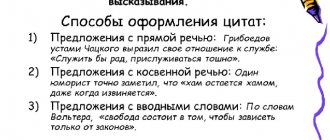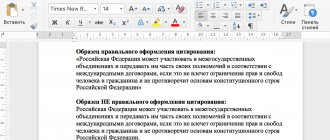Basic rules for quoting and formatting quotes in the text.
For a long time, quotations have been used by people in oral and written speech and serve as a means of confirming or for a broader disclosure of the author’s thoughts. In addition to journalistic works and scientific works, a lot of quotes today can be found on all social networks on user pages.
However, when it comes to inserting a quotation into text, many people face punctuation difficulties. In our article you will find a detailed guide on how to correctly format quotations and insert them into the text, as well as a list of punctuation marks used in the citation process.
What is a quotation?
A quotation is a statement that is used when writing articles, texts, essays for argumentation, example.
The quotation must be verbatim, indicating the addressee to whom it belongs. Thanks to citation, the author shows the completeness and breadth of the work and emphasizes originality. Quotes (from the Latin cito- “I call”, “I bring”) are verbatim (exact) excerpts from statements and writings to confirm or explain your thoughts.
Citation classification
It is generally accepted to divide all quotations into direct (literal) and indirect, when the author independently retells the text, but as close as possible to the original.
Let's take a closer look at each type of citation.
Direct Quote
Direct quotation is a copy of the author's text without changes. That is, the author saves everything: format, highlighting, grammar, etc. This type of citation is used when it is necessary to convey an idea verbatim. For example, this could be an excerpt from a law, a statistical collection, a definition of a term, or a specific and unique author's explanation of the subject of research. Direct quotation is also used by journalists and philologists when analyzing literary works.
Citation order:
1. When quoting, it is allowed to omit sentences or words and replace them with ellipses in the case where such manipulation will not affect the general meaning of the passage. When omitting a small fragment, an ellipsis (...) is placed, but if the author missed a large fragment of text, then in addition to the three dots, triangular brackets (<...>) are placed.
2. If, when reading the quotation, it is not entirely clear what or who is being talked about, or the student deliberately highlighted certain words, then an explanation is given in parentheses and the surname and initials of the author of the quotation are indicated.
Examples include:
According to Sechenov, a muscle is an analyzer not only of space but also of time: “Nearness, distance, and the height of objects, the path and speed of their movements - all these are products of the muscular sense... Being fractional in periodic movements, the same muscular sense becomes a meter or fractional analyzer of space and time" [25. With. 17].
David Dunnig:
“Incompetent people have a tendency to draw unambiguous and categorical conclusions (emphasis added – XY) or (emphasis added – XY).”
Indirect quotation
Indirect quotations represent the author's retelling of the text, or, more simply, paraphrasing. Not a single dissertation work can do without this type of citation, since it is not always possible to use a large piece of text in the form of a direct quotation or it is necessary to summarize the opinions of several authors regarding a specific issue or problem.
Translations of texts from foreign sources can also be used as indirect quotes, but the link to this quote must be in the language of its author.
To correctly format indirect citations, you need to refer to the rules of the Russian language, namely the section on converting direct speech into indirect speech. For example, “the author believes...” or “in the author’s opinion...”.
As an example, the following indirect quotes can be given:
As studies by B. Weiner show [49]. M. Seligman [14] and scientists implementing their ideas in the study of unemployment [32:33; 50]. ways of explaining successes and failures give rise to certain emotional experiences and states, influence achievement motivation, facilitate overcoming difficulties or prevent it.
Converting direct speech into indirect speech by quoting:
P. Berger and T. Luckman, in their work “The Social Construction of Reality,” wrote that conversation is the most important means of maintaining reality. Direct quote: P. Berger and T. Luckman state: “The most important means of maintaining reality is spoken communication.”
Quoting foreign publications:
Richard Thaler, speaking about modeling methods, writes that psychologists share two types of theories: normative and descriptive. (Thaleg. 2000. p. 138). References 1. Thaler R.N. From Homo Economicus to Homo Sarieps // Journal of Economic Perspectives, Vol.14, No. 1 (Winter, 2000). r 133-141.
Citation from a secondary source
You can use someone else’s citations in your thesis only in a number of clearly defined cases:
- The original work was lost beyond repair.
- Access to the original work is difficult. For example, it is in a closed fund or private library.
- The quoted text is written in a less common language, and the translation is available in only a few versions.
In case of cross-citation, it is necessary to refer to two sources: the original and the one from which the quotation was taken. However, only the secondary source is listed in the source list.
Evidence in favor of this interpretation of the incubation process is provided by J. Hadamard. He quotes A. Poincaré’s description of a sleepless night, during which a solution to a complex problem was matured, with the help of the work of the subconscious “I”” [12. With. 5].
What should the quote be?
1. Accurate. Match the meaning of the text
Let's say. You need to choose a quote for the text about the role of books in a person’s life. Chekhov wrote: “Language should be simple
and elegant.”
This statement is not correct.
“A book is a vessel that fills us, but does not empty itself,” said Adrian Decourcelles. This quote makes perfect sense.
2. Appropriate. Comply with the style and purpose of the text.
The text is created in a scientific style; the use of a lyrical poetic fragment will be superfluous.
Remember:
pay attention to ensure that the statement is not funny or offensive.
3. Necessary. The use of a quotation must be justified.
Remember:
when writing a review or essay on a text, it is appropriate to use quotes from the text itself.
4. With a minimum volume.
- A small quote is easier to remember.
- Easier to understand.
- Expresses thoughts clearly.
5. Contain correct punctuation. Then the meaning will be clear and there will be no mistakes.
Conclusion:
In order to use citation correctly, a person must have erudition, know the rules of syntax, punctuation, and citation rules. To do this you need to learn Russian and read a lot!
How to format quotes correctly: highlighting inside quotes
- In order to correctly format quotations, all selections contained in them, according to the rules, must be preserved in their original form. Exceptions are those cases when the author's emphasis does not correspond to the style of the citing publication. Then they are replaced by secretions of a different type.
- In cases where your own highlights or notes have been added to the quotations, they must be indicated. To do this, inside the quotes in brackets you should write your initials and the phrase “ my italics ” or “ emphasis added .” The original author is indicated in parentheses behind the quotation marks.
Example : “Change is always scary. But no one will change your life for you. You understand the choice you must make, but despite the fear, you move forward. This is the main rule of success (emphasis mine. - P.L.)" (Paulo Coelho).
Image 2. Example of a citation with detailed author and source information, down to the page number.
Punctuation when quoting
1. The quotation is accompanied by the words of the author. In this case, it is enclosed in quotation marks and begins with a capital letter. The remaining punctuation marks are placed in the same way as in direct speech.
Examples
- L.N. Tolstoy wrote: “The Russian language must become a world language. The time will come (and it is not far off) when the Russian language will be studied along all meridians of the globe.”
- “Before you is a huge Russian language,” N.V. points out. Gogol
- “Russian language,” noted A.I. Herzen, “is flexible, powerful, capable of withstanding both the most abstract ideas of German metaphysics and the light, sparkling play of French wit.”
Remember:
if a full quotation, punctuation as for direct speech.
A: "C"; "C", - a; “Ts, - a, - ts.”
2. The quotation is included in the author's text as part of a sentence. In this case, it is enclosed in quotation marks, but written with a small letter.
Example
- M.V. Lomonosov believed that “the Russian language is characterized by the splendor of Spanish, the liveliness of French, the strength of German, and the tenderness of Italian.”
Remember:
if a quotation is included in the author’s text as a fragment, it is formatted as a construction with indirect speech, written with a lowercase letter in quotation marks.
A, (what) “ts”
3. In the quotation, the place where the text is missing is marked with an ellipsis.
Example
- ON THE. Dobrolyubov wrote: “Our Russian language, more than all the new ones, is perhaps capable of getting closer to the classical languages...”
Remember:
if the quotation is incomplete, punctuation is the same as for direct speech. An ellipsis is placed where words are missing.
A: “C...”; A: “…t...”; A: “...ts”
4. The quotation is supplemented with introductory words: according to the words, as he wrote, as he spoke. A comma is placed after (before) the introductory word. The quotation is placed in quotation marks.
Example.
- As noted by A.P. Chekhov, “Language must be simple and elegant”
Remember:
design scheme when quoting with an introductory word
V.s, "C"; "C", v.s.
5. The quotation is framed as an independent statement. It is placed in quotation marks, and the source is indicated in parentheses.
Example
- “The Russian language in skillful hands and experienced lips is beautiful, melodious, expressive, flexible, obedient, dexterous and capacious” (A.I. Kuprin)
6.
When quoting a poetic text with exact adherence to the lines and stanzas of the original, quotation marks are not used.
Example
A. Yashin has beautiful lines about language:
I love my native language: It is understandable to everyone, It is melodious, It, like the Russian people, has many faces, It is powerful like our state
How to format quotes correctly: punctuation rules
Punctuation when quoting takes place in the 8th grade of high school. But since the topic of punctuation is quite extensive, over time people may forget some rules. To format quotes correctly, let’s consider the main options for placing punctuation marks before and after them:
- In cases where the quotation is preceded by an explanation from the quoter that what follows is a quotation, a colon is placed before the opening quotation marks.
Example : Friedrich Nietzsche once said: “What does not kill us makes us stronger.”
- In cases where inside or after a quotation there is a quotation phrase that introduces the quotation into the text, a period should be placed before the opening quotation marks.
Example: Charles Dickens had a good point about this. “A person cannot truly improve unless he helps others improve,” he emphasized.
- In cases where the quotation is part of a subordinate clause or is used as an addition, then punctuation marks are not placed before the opening quotation marks.
Example : Voltaire once said that “a person must dream in order to see the meaning of life.”
Image 3. Visual table of punctuation for quotations.
- In cases where after a quoted passage from any work there is an exclamation or question mark, as well as an ellipsis, they should be placed inside quotation marks with the quotation. There is no need to put a period after the quotation marks.
Example : Fyodor Mikhailovich Dostoevsky wrote the following lines: “Describing a flower with love for nature embodies civic feelings much more than denouncing bribe-takers...”
- In cases where there is no punctuation mark inside the quotation marks after the quoted phrase, then a period is placed after the closing quotation marks or after indicating the cited source.
Example: Leonardo da Vinci said: “He who strives for the stars does not turn around.”
- In cases where the quoted phrase is part of a subordinate clause, then after the closing quotation marks it is necessary to put a period even when at the end of the phrase inside the quotation marks there are question marks or exclamation marks, as well as an ellipsis.
Example : Arthur Schopenhauer was convinced that “every person can be listened to, but not everyone is worth talking to...”.
Basic citation requirements
- Quoted text must be placed in quotation marks and be identical to the original source. The lexical and grammatical form must fully correspond to the original.
- You cannot combine passages from different sources in one quote. Each statement is presented in the form of a separate quote.
- It is prohibited to enter citations if they occupy 30% of the text volume.
- It is unacceptable to quote authors whose texts are protected by copyright. This mainly applies to scientific papers and research texts.
Types of quotations in coursework
To know how to format a quotation in a term paper, you need to understand what type it belongs to. There are two types of citations:
- straight;
- indirect (indirect).
The answer to the question: “How to correctly format a quotation in a course work?” depends on the type of citation.
Before using quotes, you need to study the rules for their design.
Should the copyright date be updated every year?
It is necessary to understand that the dates located in the same line with the copyright do not indicate the time of existence of the site, but the time of placement of the author's content on a specific resource.
As in printed publications, site copyright materials published in one year look like: © Ivan Ivanov, 2015. If materials are published in different years, the date range is displayed: © Ivan Ivanov, 2010–2015, or you can display a specific date under each publication.
Therefore, changing the year to a new one makes sense if you have published new material on the site. However, there are a number of users who do not know about the purpose of posting copyright and thus check the relevance of the entire resource.
How to place copyright on a website
The character © has a Unicode decimal code of 169 and a hexadecimal code of 00A9. To insert a symbol into the body of a web page, you can use:
© &xa9;
In the Windows operating system, hold down the Alt key and type the sequence of numbers on the numeric keypad: 0, 1, 6, 9. Then release the Alt key.
You can also use the symbol table to display the Copyright symbol: Start > Run >
Type:
charmap.exe
and press
Enter
.
Character table in Windows
How to cite correctly in coursework
It is important not only to know how quotes are formatted in coursework, but also to remember that they must be appropriate, logically justified and convincing. There is also the concept of citation sufficiency. It can be of three types:
- insufficient citation;
- sufficient citation;
- excessive quoting.
With insufficient citation, the text of the work loses its scientific value, and with excessive citation, it makes the argument heavier and reduces the role of the author of the coursework.
Remember, other people's statements can decorate your coursework, but only when they are relevant and formatted properly.
Knowing how to correctly format citations in coursework is 50% of success
Putting a symbol in Microsoft Word
Some other methods are suitable for those who want to add a quote icon when working with documents using Microsoft Word. So, in order to carry out this procedure, you can choose one of the following methods:
- Press the Alt and 0169 keys simultaneously, as mentioned a little higher.
- In the top menu of the program, you can select the “Insert” item, and in it find “Symbol”. By clicking on it, a window with symbols will open in front of the user, from which you can select the appropriate one.
- In some versions of Microsoft Word, a quote icon is automatically added if you type the combination (c) on an English keyboard.
Above are the most common ways to add a quote icon. As you can see, there is absolutely nothing difficult about this; even a child can easily cope with all this.
Methodological standards for citation in universities
Putting a quotation in quotation marks is half the battle. It is also important to familiarize yourself with the rules for placing citations in your diploma.
- The quotation should not take up more than ⅓ of the page. This is acceptable if the student is analyzing a work of art and this quote is an excerpt.
- The maximum number of direct quotations on a page is 3. If you need to insert more quotations, alternate indirect and direct quotations.
- Quotes without analysis and explanation are unacceptable.
- You cannot use quotations in the part of the diploma where the graduate’s personal thoughts should be expressed.
- Quotes from non-scientific publications cannot be used in a diploma. For example, “Physics for Dummies”, “Law for Everyone”, “Biology from A to Z”, etc.
- Combining multiple quotes into one is prohibited.
- Quotes from publications of the pre-revolutionary period must be given in accordance with the norms of modern language. But you cannot change the style and features of the language.
- It is not recommended to cite an electronic source if it is in printed form.
The use of quotes must always be justified and supported by arguments in defense of the quote.
Reasons for citing may be the following:
- the quote contains facts that prove the student’s position in the work;
- the student’s reflections are confirmed by the opinion of an authority;
- the diploma contrasts the student’s opinion with the source of the quotation;
- The work involves analysis of works of art and the presence of quotes is mandatory.
Knowing the rules for indicating citations in a diploma, you can prepare an excellent work that will arouse the interest of the commission.
How to cite in coursework to pass anti-plagiarism
To prevent your coursework from being sent for revision due to low uniqueness, you should take the formatting of citations seriously. How to format a citation in a coursework for anti-plagiarism? To do this, you must use the correct quotation marks.
In Russian, it is customary to use “herringbone quotation marks” when quoting:
“The word is silver, and silence is gold.”
“Cut quotation marks” and other types of emphases are more often used to quote statements in foreign languages. But there is one caveat: Russian anti-plagiarism systems may not recognize them as quotations, which will lead to a decrease in the overall uniqueness of the work.
How to cite in coursework in order to comply with all the requirements of GOST and anti-plagiarism programs? It must be remembered that all citations in the coursework and in the bibliography should be highlighted using one type of quotation marks. Confusion is only permissible if you are quoting statements in another language. For example, in English:
Lewis Carroll, Alice in Wonderland: “I don't see how he can ever finish, if he doesn't begin.”
(Translation from English: Lewis Carroll's Alice in Wonderland: "I don't see how he can ever finish if he hasn't even started").
How to cite correctly in coursework to please university professors? It’s worth finding out how picky they are when it comes to formatting quotes. Many people believe that when quoting, it is always necessary to indicate not only the author, but also the source. Without this, they may lower their coursework grade.
What percentage of citations in coursework is acceptable?
Anti-plagiarism programs consider several parameters to assess the degree of uniqueness of the coursework:
- originality;
- citation;
- plagiarism.
Typically, these indicators are set by the university for each type of work. Therefore, always check what percentage is required for your coursework or other student work. Typically, the citation rate should not exceed 35%.
If you format the citations correctly, the coursework will pass an anti-plagiarism check.
How to bet: methods and their description
There are several common ways to set it up, and here are the main ones:
- You can get by with the functions of your operating system. In Windows, to do this, you need to move the cursor to the line of the text field you need, holding down the Alt key and simultaneously typing the four-digit code 0169 on the keyboard. When you lower the keys, you will see the icon. On Mac OS, you will need the keyboard shortcut Option and G.
- If you are not comfortable using the keyboard to enter a character, you can use a standard program in the operating system, the so-called character table. It can be found through the search by pressing the Win key and then Tab, and then Enter. Or you can do the second option by pressing the Win + R key combination, then type charman in the window and press Enter, and then select the quote sign.
- In the Microsoft Office Word text editor, you can find this icon in symbols or type the hexadecimal code 06A9 (A - English), and then press the combination Alt + X and the code will be replaced with a sign.
- To use it in a web browser, you can use the capabilities of HTML; to do this, just type the code in the place you need and the browser will display this symbol.
- And the simplest method is to copy a sign from an existing document and paste it into your text.









